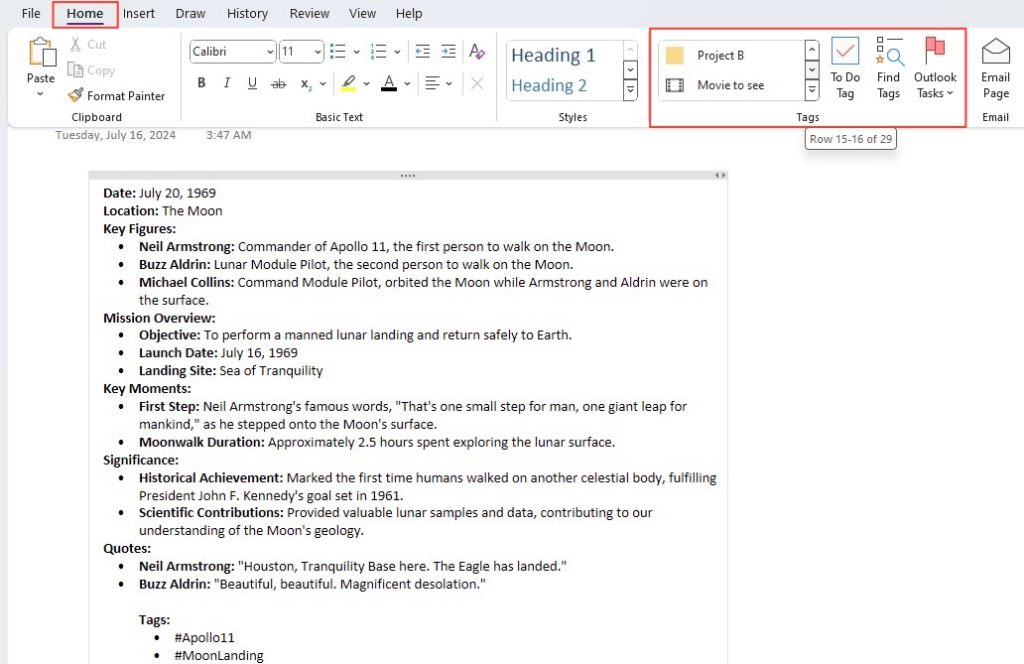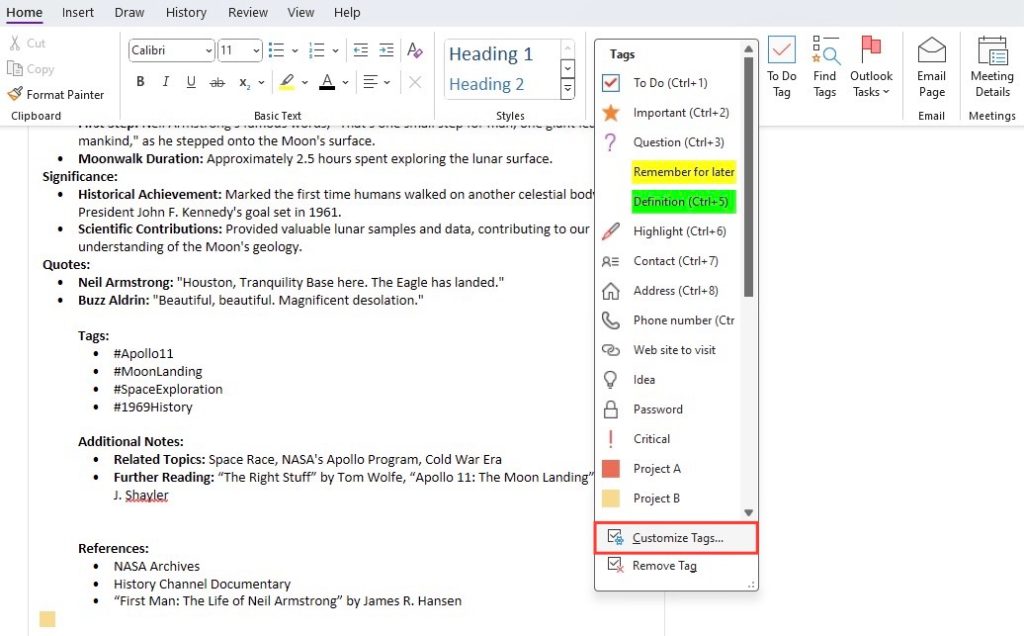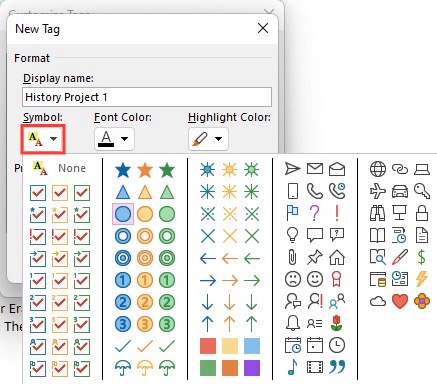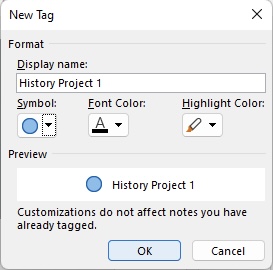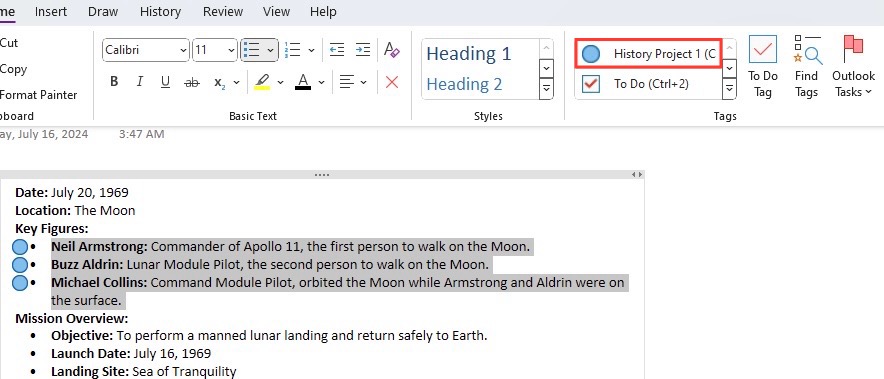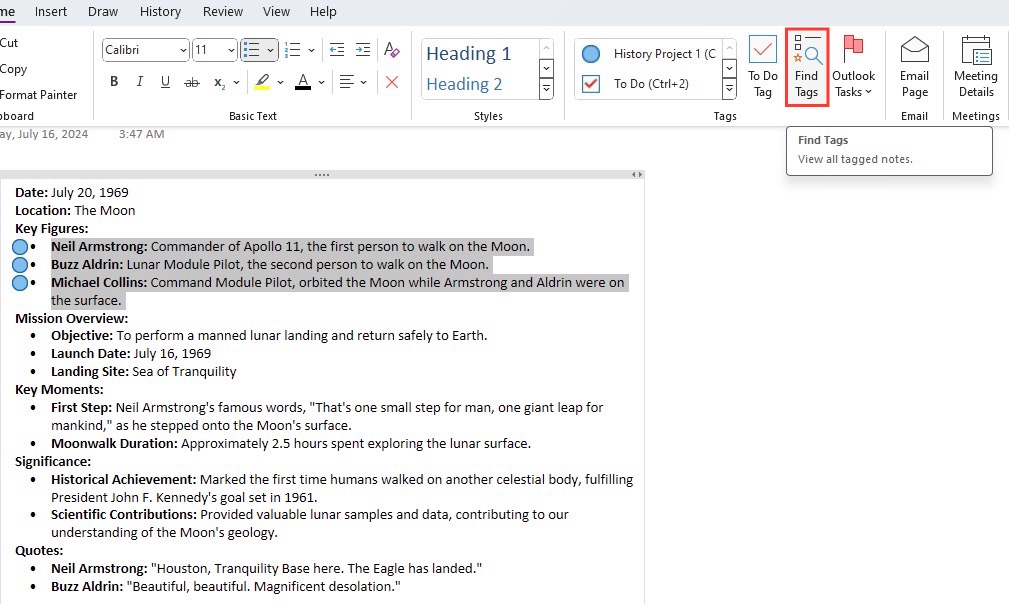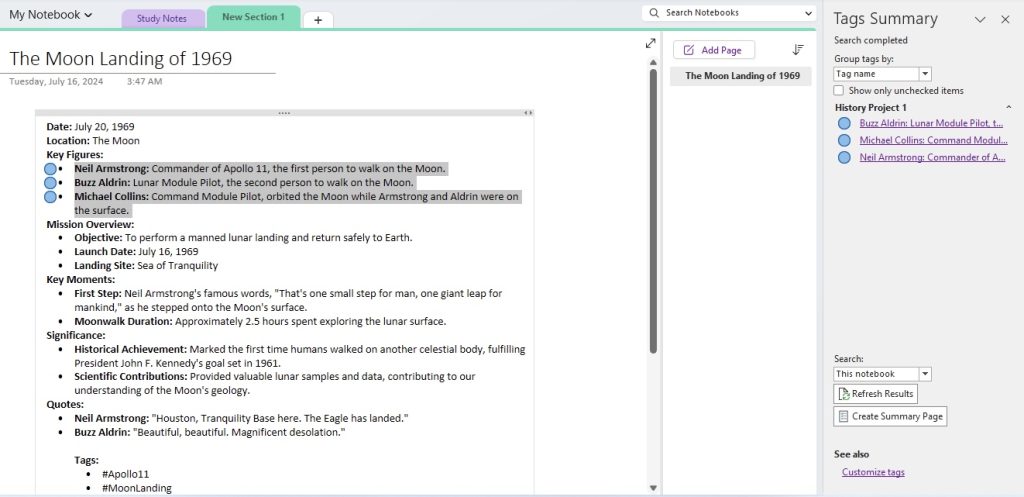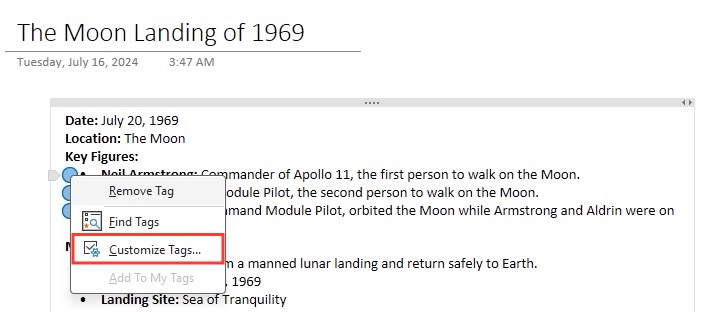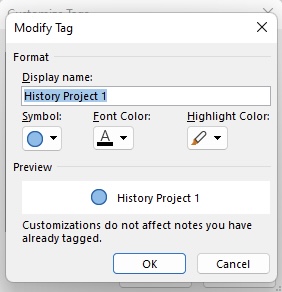Imagine tagging a note with “Important” or marking a task as “To-Do.” Later, with just a few clicks, you’re able to bring up all your crucial notes or see what tasks are pending. It’s like having a personal assistant to organize your digital notebook!
I’ve amassed quite a collection of digital notes over time, ranging from critical meeting minutes to bursts of project inspiration, down to the nitty-gritty details of class notes. It used to feel like wading through a digital swamp, trying to locate a specific piece of information amongst the multitude of pages. However, I’ve found my saving grace in Microsoft OneNote‘s tagging feature, a godsend that allows me to categorize and prioritize my notes.
Here’s how I’ve effectively used tags in OneNote to bring some semblance of order to my digital chaos:
- I quickly identify notes that require special attention by assigning them different types of tags. Whether it’s a homework assignment I need to complete or a complex concept that hasn’t quite clicked yet, tags like “To-Do” or “Question” visually stand out for me.
- With custom tags, I have the ability to tag entire pages, select paragraphs, or even multimedia content. This flexibility is key in adapting the organization to my workflow.
- OneNote’s tagging system doesn’t just stop at helping me spot important items; it brings all my tagged notes into a single pane. This makes it incredibly easy to access, search, and even print out the information I need.
- Collaboration has also been streamlined for me. When sharing notebooks, I easily assign tasks and manage my team’s workload with the tags. Each member knows exactly what they’re responsible for, and the updates are visible in real-time.
- I integrate to-do tags with various templates such as Kanban boards and calendar planners, which amplifies my project tracking and management capabilities.
Key Takeaways
- Utilize the preset tags in OneNote to label and categorize notes, making it simpler to track and prioritize different types of information or actions. For example, assign “To Do” for tasks, “Important” for key points, and “Question” for areas that need clarification.
- Apply tags to specific parts of your notes, such as to entire pages, individual paragraphs, or even to multimedia content, to help you quickly identify and focus on significant items during review or collaboration.
- Leverage tags to organize and manage project work within a team by tagging action items and using them alongside templates like kanban or calendars, thereby enhancing collaboration and project management within shared notebooks.
Quick Overview of OneNote as a Productivity Tool
OneNote is more than just a digital notebook; it’s a productivity powerhouse designed by Microsoft to keep your notes and ideas organized and accessible across all your devices. Think of it as the ultimate scrapbook for jotting down everything from doodles to web clippings, all while offering the flexibility to organize pages into sections and notebooks.
With its user-friendly interface, OneNote mimics the natural feel of a paper notebook but with the added advantage of powerful search capabilities, collaboration features, and the magical ability to never run out of pages. Whether you’re managing personal projects or collaborating with a team, OneAsyncNote’s features help keep everything in sync and flowing smoothly.
Table of Contents
Understanding the Basics of OneNote Tags
What Are OneNote Tags?
In the world of OneNote, tags are little digital assistants, small icons that pack a punch, making any piece of information in your notes stand out and become actionable. They are visual markers that can be attached to text, images, or even to-dos within your notes, acting as beacons for attention in your vast sea of data.
By using tags, you turn your notes into a well-organized system where urgency, questions, ideas, and follow-ups get their spotlight. It’s like turning on a lighthouse beam to guide you through the fog of information – tags highlight the landmarks that matter to you.
Types of Built-in Tags and Their Uses
OneNote comes equipped with a variety of built-in tags to get you started on a path to organized note-taking. These pre-defined tags cover common note-taking needs:
- To Do: Perfect for actionable items and checklists.
- Important: Highlights critical information that shouldn’t be missed.
- Question: Marks inquiries or points needing clarification.
- Remember for Later: Use this when you need to come back to something.
- Definition: Ideal when noting down terms and their meanings.
- Contact: Tags details like phone numbers or email addresses.
These are just the tip of the iceberg. Each tag not only serves as a visual cue but also helps categorize your content for later searching. By simply clicking on a tag, you can locate all instances of that tag within your notes—a real time-saver when you need to gather information quickly.
Creating and Customizing Your Own Tags
Step-by-Step Guide to Creating Custom Tags
Customizing your OneNote experience with your own unique set of tags is a breeze. Here’s a step-by-step guide to help you create tags tailored to your needs:
STEP 1: Open OneNote and click on the ‘Tag’ button to start.
STEP 2: Select ‘Customize Tags’ from the dropdown menu.
STEP 3: Hit ‘New Tag’ to craft your personal tag.
STEP 4: Name your tag to reflect its purpose—be descriptive!
STEP 5: Add a dash of personality with a symbol, a splash of font color, or a highlight to make it stand out.
STEP 6: Adjust tag options until they fit just right.
STEP 7: Click ‘OK’ to save.
STEP 8: Go to the paragraph you wish to tag and hit that ‘Tag’ button one more time.
STEP 9: Choose your shiny new custom tag from the list.
And voilà! You’ve injected your flair into OneNote’s functionality.
Tips for Personalizing Tags to Suit Your Workflow
To truly make OneNote tags serve your unique way of working, consider these tips:
- Keep it Relevant: Choose tag names and symbols that relate directly to the task or note—for instance, a lightbulb for ideas and a question mark for queries.
- Color Coding: Apply color strategically. For example, use warm colors for urgent items and cool tones for reference material. It makes visual scanning a breeze.
- Consistency is Key: Stick to a naming and symbol convention across different notebooks to maintain uniformity.
- Limit Your Palette: Don’t go overboard. Too many tags can become counterproductive. Limit your custom tags to those that add the most value to your workflow.
- Review and Adapt: Over time, your needs may change. Periodically review your tags and tweak them to match your evolving workflow.
By personalizing your tags like this, they become powerful cues that speed up your ability to navigate and manage your notes efficiently.
Organizing Notes Efficiently with Tags
Strategies for Tagging Notes for Maximum Efficiency
To turn tags into your efficiency allies:
- Prioritize with Care: Use tags to indicate priority levels within your notes. For example, you might tag action items as ‘High Priority’, ‘Medium Priority’, and ‘Low Priority’.
- Categorize Thoughtfully: Group similar content together with category-specific tags. This could be by project, topic, or even by meeting.
- Use Hierarchies: Start broad with general tags, then get more specific with sub-tags, like ‘Marketing’ followed by ‘Q1 Campaign’, ‘Social Media’, etc.
- Maintain Clarity: Reserve certain tags for specific purposes to avoid confusion over their meaning.
- Regularly Refine: Over time, clean up your tags by removing outdated ones or merging similar ones for simplicity and to maintain an efficient tagging system.
By adopting these strategies, you render OneNote’s vast canvas of notes navigable and manageable, ensuring your most crucial data is always at your fingertips.
How to Find and Edit Your Tags Quickly
Finding and editing tags in OneNote shouldn’t be akin to finding a needle in a haystack. Here’s the low-down on quick tag management:
To Find Tags Fast:
- Hit ‘Find Tags’ on the Home tab to open the Tags Summary pane.
- This pane sorts your tags by section, page, or title, displaying a neat list.
- Click any tag in the summary to jump right to the tagged note.
- Right-click on the tag you want to edit and choose ‘Remove Tag’ if you’re decluttering.
- To refresh a tag’s look or purpose, navigate to ‘Customize Tags’, find the tag, and hit ‘Modify Tag’.
- Make your changes in the dialog—name, symbol, color—and click ‘OK’ to update.
Remember, edits won’t retroactively change tags already placed in notes, so consider if a refresh is for future notes only or if you’ll revisit and update old tags too.
Advanced Techniques for Using OneNote Tags
Combining Tags with Other Features for Enhanced Productivity
To master the art of productivity with OneNote, intertwine tags with the app’s other dynamic features. Combine tags with:
- Linking Features: Use tags in tandem with OneNote’s linking capabilities to connect a tag to a specific section or page for fast referrals.
- Checklists and To-Dos: Enhance your to-do lists by tagging each item based on priority or category, then easily sort your tasks with the Find Tags summary.
- Audio and Video Notes: Tag specific moments in your recorded notes to quickly find important segments later without rewatching or re-listening to the entire recording.
Best Practices for Tag Management Across Devices
To keep your digital note ecosystem thriving across devices, follow these tag management practices:
- Sync Regularly: Ensure that OneNote is set up to sync automatically so that your tags update across all devices without a hitch.
- Consistent Tagging Conventions: Use the same tag names, symbols, and colors across devices to avoid confusion and maintain continuity.
- Use OneNote’s Cloud Capabilities: Store your notebooks on OneDrive or SharePoint for reliable cross-device accessibility.
- Audit Your Tags: Periodically check your tags on different devices to ensure they reflect your current organizational needs and that no syncing issues have occurred.
- Backup Your Notebooks: Regularly backup your notebooks to prevent data loss and preserve your tagging system.
By sticking to these practices, your tags will serve as consistent navigational beacons, no matter which device you’re on.
Integrating Tags into Your Daily Routine
Real-World Scenarios: When and How to Use Tags
Incorporate tags into your routine by visualizing these real-world scenarios:
- Project Management: Tag each task with a specific phase of the project, like ‘Planning’ or ‘Execution’, to keep your notes aligned with project milestones.
- Research Compilation: While gathering materials, tag sources with ‘To Review’, ‘Cited’, or ‘Further Research’ to streamline the writing process.
- Meeting Minutes: After a meeting, tag action items with the responsible person’s name and a deadline tag for easy follow-ups.
- Learning and Studying: For students, tag study notes with ‘Exam Material’, ‘Clarify with Professor’, or ‘Group Discussion Needed’ for varied study needs.
- Customer Interaction Logs: In customer service roles, use tags like ‘Issue Resolved’, ‘Pending Follow-Up’, or ‘Refund Processed’ to keep track of case statuses.
Embedding tags in these ways can transform how you interact with your notes, sharpening focus, and driving productivity.
Mastering the Art of Tag-Based Searches
Unlock the full potential of OneNote tags by mastering tag-based searches:
- Master the Shortcut: Press
Ctrl + Fto summon the search box and type in a tag name. OneNote will promptly display all notes with that tag. - Extend Your Scope: To skim through more than just the current page, tweak the search range using the dropdown menu; choose from Current Section, Notebook, or All Notebooks.
- Use the Summary Page: Find Tags creates a snapshot of all your tagged notes, neatly organized and ready for review. This is golden for prepping for meetings or exams.
- Combine Tags in Search: Narrow down your search further by combining tags, like finding all notes tagged ‘Important’ within a specific project section.
- Stay Updated: Regularly check for updates in OneNote, as Microsoft often enhances search features, which could improve how you use tags for searches.
By getting comfortable with these search capabilities, you elevate your ability to locate any tagged information swiftly, ensuring no note ever slips through the cracks again.
FAQs About OneNote Tags
Can You Sync Custom Tags Across Various Platforms?
No, custom tags created in OneNote don’t sync across different platforms. You’ll need to set them up individually on each device. However, as of my knowledge cutoff in 2023, Microsoft is continually updating OneNote, so it’s worth checking if this feature has been added since.
How Do You Remove or Modify an Existing Tag in OneNote?
To remove or modify a tag in OneNote, just follow a few steps. To modify, go to the Home tab, click the Tags dropdown, and then Customize Tags. Select the tag to change, hit ‘Modify Tag’, adjust the name, icon, or color, and click ‘OK’. To remove, right-click on the tag in your notes and click ‘Remove Tag’. Remember, changes won’t affect previously tagged notes.
Are There Limitations to the Number of Tags You Can Create?
As of the most recent updates, OneNote does not impose a strict limit on the number of custom tags you can create. However, creating too many can clutter your system and make it less efficient. Aim for a balance that keeps your notes organized without overwhelming your tagging system.
How Do Tags in OneNote Help with Team Collaboration?
Tags in OneNote supercharge team collaboration. They can be used to assign tasks, flag questions, or signal approval—each person knows what action to take or point to discuss. With the Tags Summary, everyone can filter out their assigned tags, cutting through the clutter for a laser-focused view on what matters to them. It’s like having a clear, color-coded communication system within your notes.
John Michaloudis is a former accountant and finance analyst at General Electric, a Microsoft MVP since 2020, an Amazon #1 bestselling author of 4 Microsoft Excel books and teacher of Microsoft Excel & Office over at his flagship MyExcelOnline Academy Online Course.

